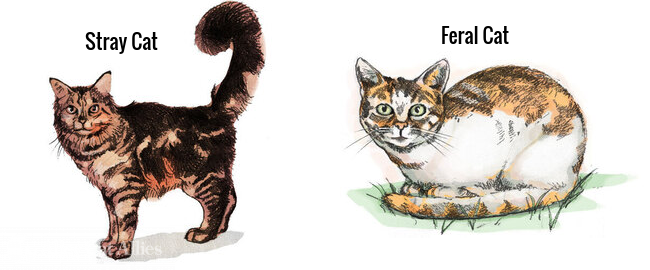Oftentimes, people tend to use the terms “stray cat” and “feral cat” interchangeably. However, there are distinct differences between the two that are important to understand. In this article, we will explore the contrasting characteristics of stray cats and feral cats, helping you to differentiate between them.
What is a Stray Cat?
A stray cat is a domestic cat that has become lost or abandoned. These cats are accustomed to human contact and have likely had previous interactions with people. They may have once been someone’s pet or have been born to a pet cat that roams freely outdoors. Due to their background, stray cats are more likely to be friendly and approachable when encountered.

Credit: m.facebook.com
What is a Feral Cat?
A feral cat, on the other hand, is a domestic cat that has either been abandoned or has been born and raised in the wild without any human socialization. These cats are typically fearful of humans and prefer to avoid contact. Feral cats often form colonies and rely on their natural instincts to survive, such as hunting for food and finding shelter in secluded areas.
Physical Appearance
In terms of physical appearance, both stray cats and feral cats may have similar features. However, a stray cat is more likely to appear well-groomed and healthy, indicating that they were recently owned or have had some human interaction. On the other hand, feral cats may have a rougher appearance, with matted fur, torn ears, and overall scruffiness due to their self-sufficient lifestyle.

Credit: www.alleycat.org
Behavior and Temperament
Stray cats tend to exhibit behaviors that are more social and friendly. They may approach humans for food or attention and may even be comfortable being touched or handled. Stray cats can be rehabilitated and become loving pets once again. In contrast, feral cats are extremely cautious and may exhibit aggressive behavior if approached. They are primarily focused on survival and typically avoid human interaction whenever possible.
Interaction with Humans
Due to their contrasting behavior, stray cats are more likely to seek human companionship and may appear around residential areas or places where they can find food and shelter. Stray cats can potentially be reunited with their owners or adopted into new homes. Feral cats, on the other hand, may avoid any human presence and are often harder to spot, as they tend to stay away from high-traffic areas.
Management and Care
Stray cats can be managed and cared for through programs such as trap-neuter-return (TNR), where they are captured, sterilized, vaccinated, and then returned to their original location. This helps control the stray cat population while also ensuring their welfare. Feral cats, however, are less likely to be successfully domesticated and may be better served by programs that provide food, shelter, and regular monitoring without attempting to socialize them.
Frequently Asked Questions For Difference Between A Stray Cat And A Feral Cat
What Is The Difference Between A Stray Cat And A Feral Cat?
A stray cat is a domesticated cat that has become lost or abandoned, while a feral cat is a wild cat that has never been socialized with humans.
How Can You Tell If A Cat Is Stray Or Feral?
A stray cat may approach humans, while a feral cat will typically avoid human contact and appear fearful or aggressive.
Are Stray Cats Dangerous?
Stray cats can carry diseases, so it’s important to approach them with caution and avoid direct contact until they can be properly evaluated and treated by a veterinarian.
How Can I Help A Stray Or Feral Cat?
Providing food, water, and shelter for stray or feral cats can help improve their overall well-being. Contacting local animal organizations for assistance is also recommended.
Conclusion
While both stray cats and feral cats share a similar origin as domestic cats, their experiences and interactions with humans have led to distinct differences in behavior and temperament. Understanding these differences is crucial when it comes to managing, caring for, and potentially rehoming these cats. By being able to differentiate between stray cats and feral cats, we can ensure that the appropriate steps are taken to provide the best possible outcomes for their well-being.
Leave a Reply